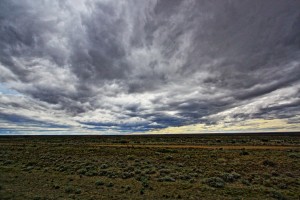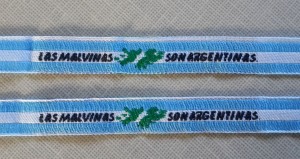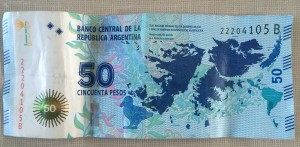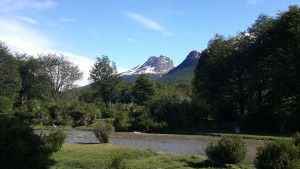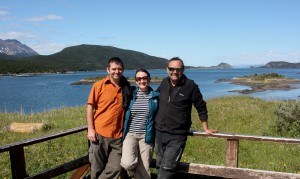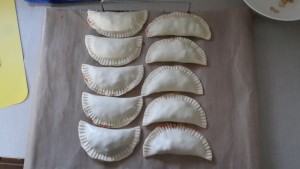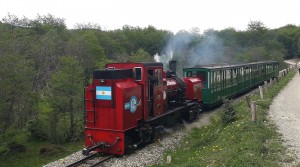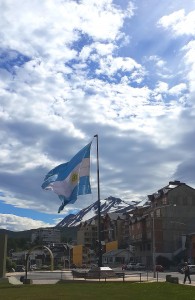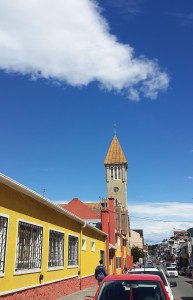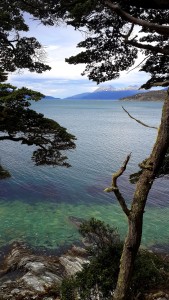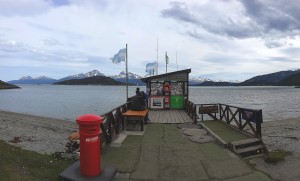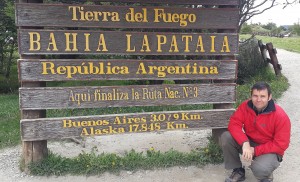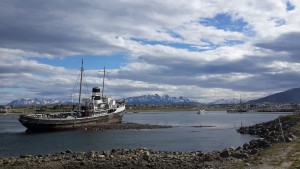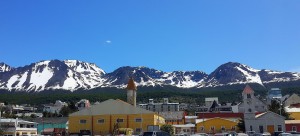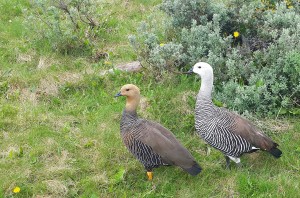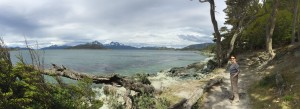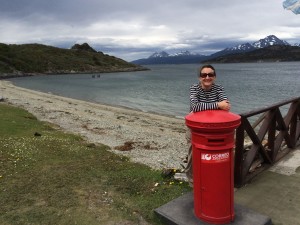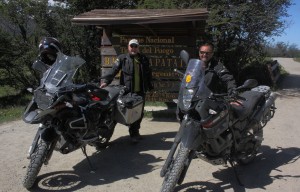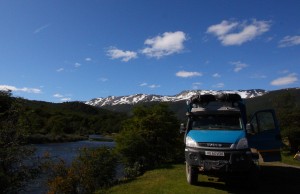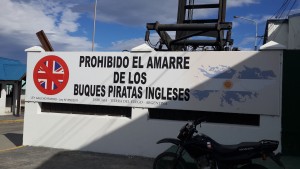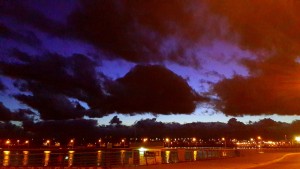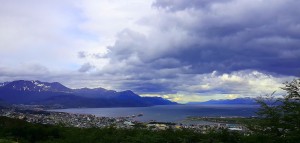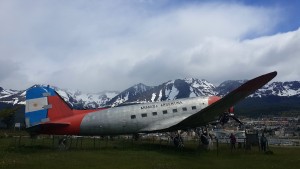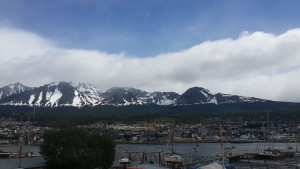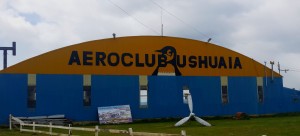Between the worthwhile sights of Patagonia there is very great deal of nothing. Vast flat pampas plains dotted with estancias/ranches, herds of cattle, roaming horses and the occasional beret-clad gaucho galloping between them. In our last blog-post we rambled on a bit about the marvellous marine and wild-life here, but what else can we say about our travels down eastern Argentina?
A big, windy place!
The first thing that struck us was the huge distances to drive. Whichever route you take to cross the pampas here, there are many hours of driving and you get nowhere fast! Argentina is a veeeery big country and we are driving far greater distances in a day than we did on our travels in Africa. The scenery is (in places) not dissimilar to Africa, although Africa’s roaming impala is replaced here by the ubiquitous guanaco/llama. We got a bit excited when we saw our first one a few weeks ago, but they quickly became a common sight in rural Patagonia.
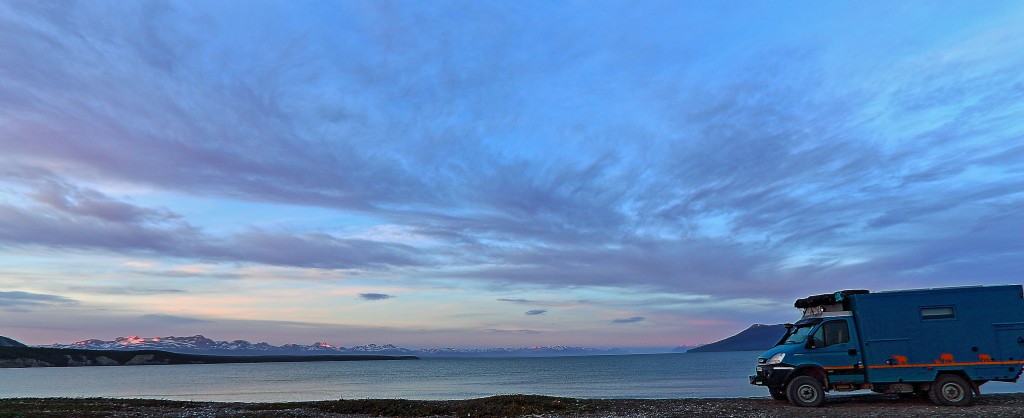 The RN3 is the main national highway running north-south down the eastern coast from Buenos Aires to Tierra del Fuego and is a good quality tarmac highway. It’s the fastest/most direct route from BA down to Ushuaia at the bottom of Tierra del Fuego, but many sections of the coast are better explored by the gravel roads which dip into the coves and beaches along the way. These are obviously much slower going, but they are Cuthbert’s preferred medium and we’re in no hurry, so we take the dirt-tracks whenever we can and tootle slowly south.
The RN3 is the main national highway running north-south down the eastern coast from Buenos Aires to Tierra del Fuego and is a good quality tarmac highway. It’s the fastest/most direct route from BA down to Ushuaia at the bottom of Tierra del Fuego, but many sections of the coast are better explored by the gravel roads which dip into the coves and beaches along the way. These are obviously much slower going, but they are Cuthbert’s preferred medium and we’re in no hurry, so we take the dirt-tracks whenever we can and tootle slowly south.
For over-night stops, there is rarely any need to find a formal campsite in Argentina. There are plenty of remote and beautiful countryside spots where self-sufficient overlanders can park-up for the night: in mountains, by rivers, on beaches. Occasionally there is a need to park-up for the night in a petrol-station truck-stop with other lorries. These are obviously less than scenic places, but the lure of free and often high-speed wi-fi can be an irresistible attraction for the occasional quick night-stop en-route.
Another factor that has featured heavily so far, is the wind. Many mornings we have woken up to what Winnie-the-Pooh might have described as ‘a blustery day’ 🙂 !! Patagonia is well known for its constant high winds coming off the South Atlantic across the plains. Those in the know explain that we now sit further south than any other land-mass on the planet (other than Antarctica, obviously!). The wind off the great oceans whips around this latitude of the globe with no other continents to break it. It hits the Argentine coast with a persistent and steady force, causing an enduring topic of conversation amongst overlanders of where best to park overnight for shelter. In Cuthbert we consider ourselves to be particularly fortunate in this respect; in all but the most extreme circumstances, we simply park nose-into the wind and (provided of course the wind doesn’t inconsiderately change direction in the night) we secure a fairly ‘rock & roll’ free night. This is not the case for the overlander with a tent pitched, or a pop-up roof on their campervan, who needs to be particularly choosy where to stop for the night.
The southerly latitude and the approaching summer season combine to create another key factor that is affecting our travels so far: the very long days. Late November in southern Patagonia and day-light is almost 18 hrs per day; we really enjoy the long evenings and it’s a great boost for our solar power system. When we were in southern/central Africa earlier this year, we had only around 12 hrs of daylight; darkness fell by 17:30 hrs and we sometimes had difficulty harvesting enough solar to keep the fridge cool over the long nights.
The Falklands/Malvinas Factor
The first road-side sign that we saw on entering Argentina from Uruguay a few weeks ago was one of the “Las Malvinas son Argentinas” which appear periodically around the country. There seems to still be at least a small amount of enthusiasm for Argentina’s claim to the islands, but it’s difficult to tell quite how deeply this runs through the community. As Brits, we have so far received nothing but a very genuine and warm welcome from everyone we have met, but we are mindful of the anti-British feeling stirred-up by the ridiculous antics of Clarkson and the Top Gear team less than a year ago and also of the anti-British demonstrations outside the British Embassy in Buenos Aires just a week or so before we arrived last month. Last week a general election resulted in the new President Macri taking over from the outgoing Kirchner. His early speeches indicate that his focus in office will be sorting out the rather dire economy rather than any review of the Falklands/Malvinas issue, so if there is any underlying public feeling, it hopefully won’t be stirred up for political reasons during our time here.
Readers of our earlier Buenos Aires blog-post may recall that we decided against visiting a Malvinas Museum in a far-out suburb of BA, but down here in the most southerly mainland town of Rio Gallegos, there is another Malvinas Museum advertised in a central tourist location. Rio Gallegos was the main HQ and one of the main operating bases for the Argentinian invasion and the subsequent war. No doubt many of the families here lost sons, fathers and brothers. The museum is advertised to explain the historical reasons for the Argentinian claim to the islands, so we went to see it with interest.
Perhaps not surprisingly, we were the only visitors there and the attendant opened the museum up for us as we arrived. He was a friendly chap and cheerfully showed us around, but on identifying that we are English, started to question us (in Spanish) about the views of the English people regarding the islands. Ummmm… awkward!! I treated the subject as politely yet evasively as I could, but sensing my evasion tactics, he tried a different approach by explaining how much our British people dislike the Queen and the royal family; not even the Scots or the Northern Irish want to be part of the Union he explained, so why should the Falklanders be British? So that told us then 😐 ! Smiling politely we accepted his small gifts of: (a) a ‘Las Malvinas son Argentinas’ wrist band that we should apparently each wear with pride; and (b) a short leaflet-guide on ‘How to visit Las Malvinas’ should we like to see it for ourselves one day. We conveniently omitted to mention that Marcus was already particularly familiar with the islands, having spent over 6 months there flying patrols while in the RAF 🙂
And in case anyone is wondering, after having visited the museum, we are still none the wiser as to what exactly Argentina’s historical claim to the islands actually is. The museum has some interesting displays about the events of the war and the forces deployed by both sides, but nothing we saw in the museum explained the ‘official’ version of exactly why the war should have happened at all.
So if, as is widely understood by many people outside of Argentina, the Galtieri Falklands invasion was a tactic to distract the population from the dire economic situation prevailing in the early 1980s, how is Argentina’s economic situation today? Well first… don’t panic… relax… this isn’t ‘Time’ magazine; we have neither the intellect nor the interest to provide any incisive economic analysis of these things. But we can comment briefly on one particular point that has a significant impact for the overlanding tourist
At the end of Kirchner’s term, Argentina’s economy cannot exactly be described as ‘going from strength to strength’. The value of the Argentine Peso (AR$) is suffering and the government brought in controversial currency controls. We have absolutely no idea what this means in terms of the Argentine macro-economy; but in real life for us it means that the demand for the more stable US dollar is high and there are people out there prepared to pay far more for a US$ ‘greenback’ than the official bank rate of around AR$9. So let us now introduce you to ‘The Blue Dollar’: the rate at which certain people are prepared to purchase US dollars, up to 40% higher than the official bank rate. Naturally this unofficial exchange rate is not strictly in accordance with Argentinian law, but the law seems to be widely and flagrantly breached by many businesses around the country.
So the question for travellers is whether to partake in such activity? We have heard that at the ‘safer’ end of the spectrum, some (but only some) hotels, shops and restaurants will accept payment in US$ at the Blue Dollar rate and may, if you are lucky, exchange a bit more cash than the purchase price. At the more ‘dodgey’ end of the spectrum, there are chaps out on the streets in BA’s tourist areas shouting “cambio, cambio” (“change, change”) and who then take any interested ‘clients’ down a side-alley to do ‘business’.
Generally speaking, breaking laws in South American countries would be described as a ‘bad thing’; but where do we put this one in degrees of ‘badness’? Not only, as we said, is the Blue Dollar rate offered ‘off the record’ by respected and otherwise law-abiding traders and businessmen, but the newspapers even publish the daily Blue Dollar exchange rate like any other currency. The authorities seem therefore to be mostly turning a blind eye to the Blue Dollar practice, but the deals are still done ‘under the counter’ and there are still many businesses that won’t associate themselves with the skulduggery. Enforcement by the authorities is therefore clearly not entirely absent, but we haven’t managed to establish the extent to which the law is (or isn’t) enforced.
So should we try to buy at the Blue Dollar rate and effectively reduce all our spending in Argentina by 40%? We are going to be spending here for several weeks at least, not to mention the cost of the fuel for the thousands of miles we’ll be driving, so the 40% saving will not be a trivial amount of money. We decided early on that we did not like the look of the ‘cambio, cambio’ chaps on the streets and would not be doing any deals with them down any side-alleys. The risk with these chaps would appear to be not really one of personal safety (although that aspect obviously has potential) but more one of being given counterfeit AR$ in return for your US dollars.
We decided to stick with a ‘half-way-house’: pay for as many items as we can in shops/ restaurants with US$ bills at the Blue Dollar rate, and if any traders would at the same time, exchange a few extra dollars, we would gratefully do so. But if they were not interested we would use Pesos that we had obtained from the ATM at the official rate. Our most significant travel cost by far, is diesel for Cuthbert and we found some fuel stations prepared to accept the Blue Dollar rate in payment.
Since we arrived in Argentina, the Kirchner years have ended with Señor Macri winning by a narrow margin in the general election last week. He formally takes office in a couple of weeks and has promised to rectify the currency control situation. Will this be the end of the Blue Dollar? Watch this space to see how his policies impact the overland traveller in 2016 🙂
Towards the End of the World
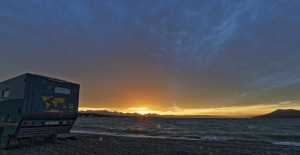 Meanwhile… back to the travels… we are leaving Rio Gallegos heading down to Tierra del Fuego in (by far) the strongest winds that we have had so far. We have no formal measure of the force, but trees are bending over; it is difficult to open the car doors; hard to walk and stand-up in places; and steering the high-sided Cuthbert down the RN3 highway with a cross-wind was a challenge.
Meanwhile… back to the travels… we are leaving Rio Gallegos heading down to Tierra del Fuego in (by far) the strongest winds that we have had so far. We have no formal measure of the force, but trees are bending over; it is difficult to open the car doors; hard to walk and stand-up in places; and steering the high-sided Cuthbert down the RN3 highway with a cross-wind was a challenge.
Some 30ish kilometres before the Magellan Straights at the bottom of mainland South America, Argentina and Chile have a rather inconvenient zig-zag border arrangement, by which you have to cross the border into Chile before sailing across to the island of Tierra del Fuego. Once on Tierra del Fuego, the northern section of the island is still part of Chile, but then half way down the island you cross back into Argentina to reach the most southerly town of Ushuaia, dubbed ‘The End of the World’ (to see the inconvenient border arrangement click South America Route Map).
So our first hurdle of this section of our journey is to enter Chile. This should in theory be a fairly relaxed affair, no visas or complicated administrative procedures, but it is not so straight forward when you are travelling with an overlander’s well-stocked food-store. The range of food items prohibited from entering Chile is extensive (or rather, the range of permitted items is limited) and although the Customs officer is friendly, he does a more than cursory job of searching Cuthbert’s cupboards. Thankfully, due to some ‘tactical tips’ gratefully received from our friends Steve and Gilly who have been before us, the experience was not too onerous. We surrendered an apple, an onion and two eggs and we were soon on our way to ‘Hurdle Two’: the ferry crossing.
The ferry crossing of the Magellan Straights is sited at a narrow point, sailing for only around 20 minutes. As we approached the slip-way on the mainland side at around 18:30hrs in the evening, we joined a queue well over half a kilometre long and two lines deep! Nothing seemed to be moving, but a chat with that well known source of reliable travel info – the lorry drivers, revealed that sailings are suspended due to the wind. We looked at the number of vehicles ahead of us and guessed that once the boats start again, there are at least 3 full ferry loads to go before we will be at the front of the queue. Arrggh! Thankfully, due to Cuthbert’s amazing hospitality, we are more fortunate than most of the other travellers waiting in their cars to board: we have the luxury of waiting in our own lounge with tea and biccies 🙂 Eventually at around 21:30 hrs the boats started running again, and by 22:45 we were boarding on the third ferry… we’re chuffed to be on our way again!
Tierra del Fuego
Boarding the ferry, the wind and sea had calmed considerably from the earlier state but it was still pretty choppy. The waves were crashing over the top of the high-sided, open-top boat, washing down on the vehicles on the deck. We sat in Cuthbert as the ferry rolled from side to side throughout the short crossing then, as we approached the arrival slip-way, the swell rose even higher and the ferry seemed to have problems putting to land. The ramp was eventually lowered but couldn’t reach the slip-way properly and the waves were washing over the vehicle access. The lorries starting rolling off the ferry into the darkness via a submerged (and constantly shifting) drive-off ramp. Cuthbert took his turn and made it through the surf to terra-firma. It was late, it had been a long day, we were tired and a bit concerned about the corrosive salt-water bath that Cuthbert received in transit, but we found a sheltered spot to park up for the rest of the night and get some kip.
Tierra del Fuego or ‘Land of the Fire’ is so far south that even in the current summer season, it doesn’t really reflect the warmth that it’s name implies. So how come the name has its infernal incinuation? Well… the story goes… back in the time of the early European explorers and settlers, they arrived on the island to find the indigenous tribes wearing no clothing, wraps or animal skins of any kind. They relied solely on the lighting of fires for their survival warmth. Given the persistently chilly climate here, it is difficult to believe how anyone with the option of a bit of brontosaurus hide (ok, well perhaps more realistically, seal skin) to cover their bits would choose to roam naked. But there you go… it takes all sorts 🙂 . So apparently, this wide-spread reliance on fires for survival is why the island was so named.
The target destination of most travellers arriving in Tierra del Fuego is the large port town of Ushuaia on the far south of the island. To get there we drive across the island through very scenic mountains and lakesides. It is late spring/early summer, the region’s small ski resort has closed for the season, but there is still a generous coat of snow across the mountain tops as we descend over the high pass and down into Ushuaia on the edge of the Beagle Channel.
It’s the End of the World (as we know it)
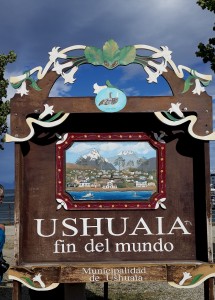 Ushuaia holds itself out as ‘El Fin del Mundo’ (The End of the World) and seems to be the world’s most southerly town of substance. However, just to the south of Ushuaia is the island of Navarino. It is largely uninhabited save for the tiny town of Puerto Williams. The island belongs to Chile and hence Puerto Williams vies with Argentina’s Ushuaia for the title of world’s most southerly ‘town’. But we can’t take Cuthbert to Navarino island, so with due apologies to Chile, we’ll be stopping Cuthbert’s southerly journey here in Ushuaia and acknowledging its claim to be ‘The End of the World’.
Ushuaia holds itself out as ‘El Fin del Mundo’ (The End of the World) and seems to be the world’s most southerly town of substance. However, just to the south of Ushuaia is the island of Navarino. It is largely uninhabited save for the tiny town of Puerto Williams. The island belongs to Chile and hence Puerto Williams vies with Argentina’s Ushuaia for the title of world’s most southerly ‘town’. But we can’t take Cuthbert to Navarino island, so with due apologies to Chile, we’ll be stopping Cuthbert’s southerly journey here in Ushuaia and acknowledging its claim to be ‘The End of the World’.
The RN3 highway from Buenos Aires finally ends just 12 km past Ushuaia in the Tierra del Fuego National Park. Having journeyed all this way, it would be remiss of us not to continue past Ushuaia to the very end of the road. From here, the only way for Cuthbert is north. There is a sign indicating 3,079 km to Buenos Aires and 17,848 km to Alaska. It was disappointing that the sign is located such that we couldn’t get Cuthbert close enough for a photo, but we took one of us there just to prove we made it 🙂 . Soon we’ll be joining the very long list of ambitious travellers who have gone before us and set-off from this point, all the way up the Pan-American highway to Alaska. We have no idea how long it will take. Don’t hold your breath… we’re in no hurry 🙂
Operation ‘Go South’
But before we head north in Cuthbert, we have one excruciatingly exciting mission… to go even further south!!! “Uh? Didn’t you say the only way is north…?” Well… Top Marks if you noticed that ‘the only way for Cuthbert is north’. That doesn’t mean that we can’t look for a ship to sail to Antarctica!!! Holey moley!!! How utterly and fabulously thrilling is that????? 🙂
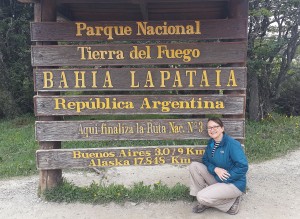 Ushuaia is the port from which almost all Antarctic cruises depart. Should you peruse appropriate travel brochures in your home country, you will find Antarctic cruises advertised at staggeringly eye-watering prices, bookable around a year to 18 months in advance. However here in Ushuaia, there are many agencies selling last-minute deals to fill up the vacancies on the ships just days before they set sail. If you have the luxury of time to come here and hang around for a week or two, you can get a mega-mega bargain at a fraction of the full price. Having done a great deal of research into options, routes, ships and so on before we got here, plus a bit of leg-work around town, we have finally found a good deal on the MV Sea Adventurer departing next week. Now it’s booked, we simply can’t wait…. just seven more sleeps!
Ushuaia is the port from which almost all Antarctic cruises depart. Should you peruse appropriate travel brochures in your home country, you will find Antarctic cruises advertised at staggeringly eye-watering prices, bookable around a year to 18 months in advance. However here in Ushuaia, there are many agencies selling last-minute deals to fill up the vacancies on the ships just days before they set sail. If you have the luxury of time to come here and hang around for a week or two, you can get a mega-mega bargain at a fraction of the full price. Having done a great deal of research into options, routes, ships and so on before we got here, plus a bit of leg-work around town, we have finally found a good deal on the MV Sea Adventurer departing next week. Now it’s booked, we simply can’t wait…. just seven more sleeps!
Shipmates
Regular Cuthbert readers may remember solo-biker ‘Shipmate Phil’ who we met on the Grande Nigeria sailing to Montevideo (yes, he of the ‘tattoo’ with caipirinhas in Rio). Phil was last seen by us at the Uruguay/ Argentina Fray Bentos border, but we’ve now received a message that he is Ushuaia-bound just one day behind us. Phil has taken a very different route to us to get here, but it is great to meet up with him again, sample together some of the fine Argentinian wines and reminisce over our Grande Nigeria days.
Although Phil set off on his travels as a solo biker, he has en-route paired-up with another solo biker, ‘Wayne the Kiwi’. Shipmate Phil introduced us to Wayne in Ushuaia and it turned out that, funnily enough, ‘Wayne the Kiwi’ is about to become ‘Shipmate Wayne’, joining us on the MV Sea Adventurer to Antarctica in a few days.
After booking the cruise we had a few days to waste in Ushuaia. After all the driving over the last few weeks, it was nice to stop and be in one place for a while and have nowhere to go. We relaxed in town for a couple of days seeing the sights and mooching around the shops, we did some reading, day-hiking and… oh yes, I nearly forgot… some cooking! For the ‘Doubting Thomas’ amongst you, pictorial proof is provided… see! Homemade empanadas!!! 🙂
Finally, the exciting sailing day has almost arrived – tomorrow we set sail again!! We didn’t need any sea-sickness tablets on the Grande Nigeria but crossing Drakes Passage, one of the roughest seas in the world, on a much smaller ship might be a bit different… 😐 Watch this space for the full story and hopefully some great pics when we return before Christmas.
Link to next blog: Antarctica Link to full South America Blog
Tierra del Fuego – Ushuaia Gallery

